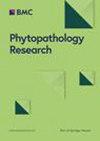Characterization of the triadimefon resistant Puccinia striiformis f. sp. tritici isolates in China
IF 3.5
2区 农林科学
Q2 PLANT SCIENCES
引用次数: 0
Abstract
Abstract Wheat stripe rust, caused by Puccinia striiformis f. sp. tritici ( Pst ), is a devastating disease that seriously threatens the production of crops worldwide. Triadimefon is the widely-used fungicide for controlling the disease in China; however, as the fungicide targets a single site (position 401 in the 134th codon of the Cyp51 gene), the extensive application imposes a strong selection pressure on the pathogens, which may potentially lose the effect over time. In this study, 176 Pst field isolates sampled from different regions of Xinjiang were determined for their sensitivity to triadimefon because it is the few frequent Pst outbreak and representative area in China. The results showed that the Pst isolates collected from Yili, Xinjiang, exhibited a strong resistance to triadimefon with an average EC 50 of 0.263 µg/mL, despite the rest of the isolates maintaining high sensitivity to triadimefon. The triadimefon-resistant and triadimefon-sensitive isolates did not display significant differences in sporulation, but the triadimefon-resistant isolates exhibited weaker adaptive traits in their latent period and urediniospore germination rate than the triadimefon-sensitive isolates. No cross-resistance was found for the other two fungicides, flubeneteram or pyraclostrobin; however, cross-resistance for the demethylation inhibitor (DMI) fungicides, tebuconazole and hexaconazole, was found. Genome sequencing revealed that the Tyrosine (Y) at 134 residue was mutated to Phenylalanine (F) in the Xinjiang isolates. Our study revealed that a natural mutation in Pst led to the efficacy loss of triadimefon to control the disease.中国小麦纹状契诃夫氏菌耐三嘧唑啉分离株的鉴定
摘要小麦条锈病是由小麦条锈病(Pst)引起的一种严重威胁世界农作物生产的破坏性病害。triadimeon是中国广泛使用的杀菌剂;然而,由于该杀菌剂靶向单一位点(Cyp51基因第134密码子401号位置),因此广泛应用对病原体施加了强大的选择压力,随着时间的推移可能会失去作用。由于新疆是中国少数Pst多发地区和代表性地区,本研究对新疆不同地区的176株Pst野外分离株进行了对三嘧唑酮的敏感性测定。结果表明,来自新疆伊力的Pst分离株对三嘧霉啶具有较强的抗性,平均EC 50为0.263µg/mL,其余分离株对三嘧霉啶保持较高的敏感性。三嘧霉霉抗性和三嘧霉霉敏感菌株的产孢量差异不显著,但三嘧霉霉抗性菌株的潜伏期和脲孢子发芽率的适应特征弱于三嘧霉霉敏感菌株。另外两种杀菌剂氟虫胺和嘧菌酯未发现交叉抗性;然而,对去甲基化抑制剂(DMI)杀菌剂戊康唑和六康唑发现交叉耐药。基因组测序结果显示,新疆分离株134个残基酪氨酸(Y)突变为苯丙氨酸(F)。我们的研究表明,Pst的自然突变导致三唑美酮控制疾病的功效丧失。
本文章由计算机程序翻译,如有差异,请以英文原文为准。
求助全文
约1分钟内获得全文
求助全文

 求助内容:
求助内容: 应助结果提醒方式:
应助结果提醒方式:


